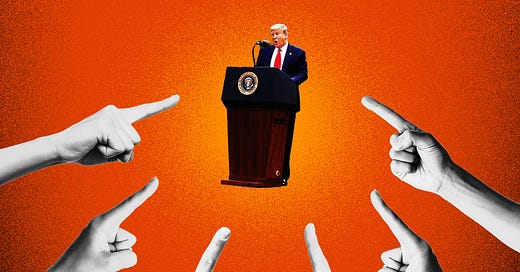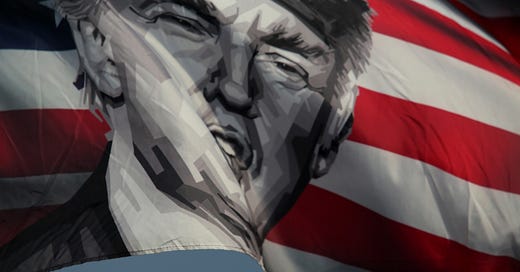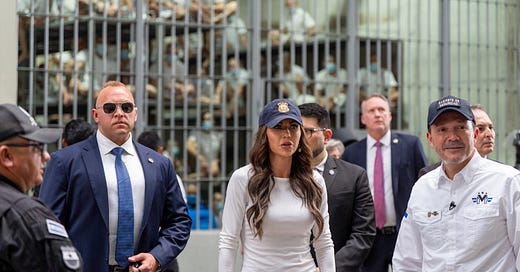
Why Don't COVID-19 Truthers Blame Trump for Anything?
If shutting down the country is the worst thing ever then why isn't Trump getting shredded by the people who think it's a gross overreaction?
1. A Serious Question
I've been consistently boggled by the loose affiliation of coronavirus-truthers, America Firsters, Catholic rad-trads, and economic boosters who have come together over the last month to insist that:
(1) COVID-19 isn't so bad. (2) The real problem is the economy and the lunacy of shutting America down.
These people all seem to have different reasons for wanting America to "re-open." The only thing they have in common is that they all—from the Taliban Catholics to the alt-right trolls, from the conspiracy cranks to Peter Navarro—love them some Trump.
But here's where it gets strange: I have not seen any of these folks criticize Trump for his part in shutting the country down.
Ask these folks who it is who has brought America to her knees and you'll get lots of different answers:
Lilly-livered bishops
Anthony Fauci
The Chinese
Bill de Blasio
Andrew Cuomo
The Democrats
The Jews
The Media
Scientists
The elites
The Imperial College
If you have seen someone from the #ReopenAmerica brigade blame Trump, please send me the clip. Because as of now I have literally never seen anyone from that part of the world blame Trump for America's shutdown.
How could that be? He's the president! If Anthony Fauci is the villain in all of this, and Trump hasn't fired him by now, then Trump is at least a dupe and maybe an accomplice.
On March 16, Trump urged Americans to social distance for 15 days. He later extended that timeline. If COVID-19 is really no big deal and if reopening America is the most important thing in the world, then why aren't these people flaying Trump every minute of every day and exhorting him to stop this madness?
Truly, it is a mystery.
2. Undercounting
I keep banging on about undercounts in our COVID-19 death totals. New York City did something about it yesterday. The city:
increased its death toll by more than 3,700 victims on Tuesday, after officials said they were now including people who had never tested positive for the virus but were presumed to have died of it.The new figures, released by the city’s Health Department, drove up the number of people killed in New York City to more than 10,000, and appeared to increase the overall United States death count by 17 percent to more than 26,000. . . .
The outbreak is likely to have also led indirectly to a spike in deaths of New Yorkers who may never have been infected.
Three thousand more people died in New York City between March 11 and April 13 than would have been expected during the same time period in an ordinary year, Dr. Oxiris Barbot, the commissioner of the city Health Department, said in an interview. While these so-called excess deaths were not explicitly linked to the virus, they might not have happened had the outbreak not occurred, in part because it overwhelmed the normal health care system.
“This is yet another part of the impact of Covid,” she said, adding that more study was needed. . . .
But for weeks, the Health Department also had been recording additional deaths tied to the virus, according to two people briefed on the matter. Those cases involved people who were presumed to have been infected because of their symptoms and medical history. . . .
Mr. de Blasio decided, after another round of briefings over the weekend, to release the presumptive cases, the people said. Most of the added deaths took place in hospitals, according to the data. Others occurred in nursing homes or other long-term care facilities and in residences. On the one hand: This is good. On the other hand: I don't like it.
The point of getting good data is so that you can use it get a clearer picture of what's going on in the real world around you.
And the point of this release has nothing to do with data and everything to do with the fact that the New York Times ran a story about undercounting over the weekend and Bill de Blasio—who is going to go down as the worst mayor in the history of modern New York—was getting static about it.
So this is nothing more than a knee-jerk comms reaction.
Now, does this move also happen to help make our picture more clear? In some ways, yes. It tells us more accurately what the mortality/morbidity numbers in New York City look like. But how much more accurately? We don't really know. What we have seems to be a list that was being compiled on the fly by city health officials. How complete is it? What sort of over- or under-counting is it doing? What sort of standards are being used and how accurate do we think they are?
But the biggest problem is this: In order to get the best data possible, we need nationalized standards for this count.
In a certain way, limited the death count only to confirmed positive test cases makes sense. But having NYC supplement this count with its own death records and assumptions while other cities and/or states hold to the positive-test standard—or come up with their own supplemental counts—is going to make the data messier.
It's tempting to wait and have all of this sorted out by a giant, multi-institution, peer-reviewed after-action report. That's the closest we'll ever get to getting a "true" count.
But the problem is that different institutions, from local, to state, to the federal governments, are going to have to make a series of decisions over the next 12 weeks or so.
They'll have to decide where to send tests. Where to allocate PPE supplies. Where and how to sample in the coming surveillance regime. Where (and when) it's safe to ease mitigation efforts.
And having a true count sooner, rather than later, will provide better information to guide those decisions.
I would have assumed that, somewhere in the federal government, someone is putting together protocols for tabulating untested, COVID-like deaths and liaising with all of the relevant people in the states and localities to keep everyone on the same page.
Then again, I've assumed a lot of things about the federal government's handling of this pandemic.
3. Big Purple
And oldie but a goodie from the great Chris Lehmann about what Yahoo News looked like from the inside:
Yahoo, too, was keen to curb its costs. It had partnership contracts with several high-profile media companies, all of which were delighted to see their product dragged in front of millions of Yahoo-branded eyeballs. But as their print clientele abandoned them, these companies also sought to pad their own sagging bottom lines by hiking up their licensing fees and charging Yahoo more. Emboldened by the success of the sports blog network, Yahoo executives figured they could produce news product far more cheaply in house. After all, they already had, in spades, the main asset that the rest of the mediasphere was starved for: readers. All they needed now was a team of enterprising reporters and editors to keep daily, and hourly, content buzzing through the company’s outsized distribution system.
That’s where I came in. I was hired in an overheated blur of Silicon Valley hype. My formal job offer came packaged in a FedEx box that had been rigged up to deliver the company’s irksome trademark soprano “Yahoo” each time you opened it. Even after I rushed it into my kitchen trash can, it would start in on its infernal yodeling loop whenever I’d discard a used yogurt carton or wadded-up paper towel on top. It was the branding mechanism that would not die.
A related ominous portent, as I discovered upon opening my big purple yodeling box, was that the company’s HR team had adopted the cutesy-to-them tic of referring to employees simply as “Yahoos”—making us seem either like backwoods rubes or (to more literary-minded hires) the ravenous creatures in Gulliver’s Travels who manage to combine both elitism and boorishness, digging through the muck to retrieve jealously hoarded precious stones. Here, too, was a parable in miniature: Yahoo, the company, clearly was keen to have me adopt the classic Swiftian version of the Yahoo identity. Read the whole thing.











